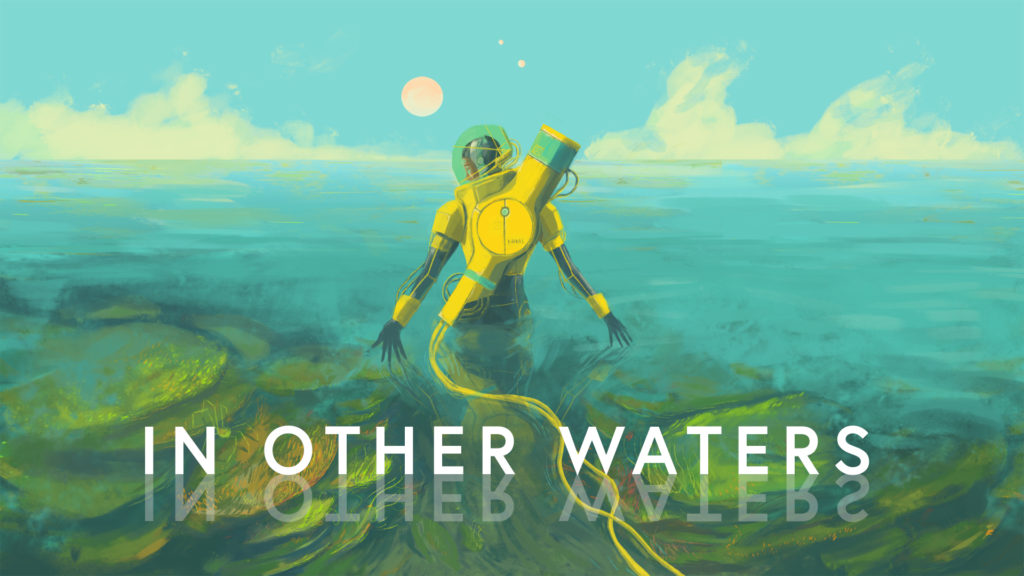
Minimalism is something we don’t see a lot of in gaming. Flashy explosions, high-end graphics, and wild character designs aren’t just the norm, they’re hotly anticipated. One of the biggest talking points about gaming is graphics. Are they good? Is it cool? What does it look like? Not everything has to be that way though, and In Other Waters from indie studio Jump Over The Age and publisher Fellow Traveller Games does just that. In Other Waters is, at its core, a vintage text adventure. Rather than a person, you actually play an AI that possesses only rudimentary communication skills and operates a highly advanced dive suit. Now, don’t expect your standard text adventure quips and misspellings here. This is a whole different level of narrative, raising the bar to an art form rather than a rollicking romp.

But can today’s audience be entertained by a text adventure? It turns out that you absolutely can. As an AI, you are assisting Ellery, a xenobiologist (or maybe a xeno-marine biologist?) on an exploration of an alien marine ecosystem while she looks for her lost coworker, a scientist named Minae. This doesn’t sound like the most exciting premise out there, and this isn’t a pulse-pounding, edge-of-your-seat adventure either, but it’s astonishingly immersive nonetheless. No spoilers here, as a game like In Other Waters is entirely dependent on plot and ruining that would just be unconscionable.

As a program, you control Ellery’s movement in every aspect through an absolutely elegant control panel which is your main contact with the world outside. You have navigation, air supply, power, directional control, depth, and everything else you might need on your journey. Ellery’s comments feed to you through a text box at the bottom of the screen and the sonar takes up most of the useable screen area. The entire beginning of the game is a cool aqua blue with shades of yellow outlining everything and it’s one of the most well-designed, gorgeous interfaces out there. Everything has its place and moves seamlessly as you control the suit. From the navigation by sliding the compass around to locking in on a promising organic sample, the care taken with the design of the control interface is evident in every detail. Every button press feels crisp and responsive; avoiding what could have been a game-breaking issue in a title that plays out entirely through menu systems. Honestly, the panels and sub-menus are so well-designed that it’s absolutely devastating that Gareth Damian Martin, the man behind one-man studio Jump Over The Age, isn’t designing the interfaces for operating systems like Windows and Android. It’s hard to explain how clean and relaxing they feel while also using unexpected color schemes.
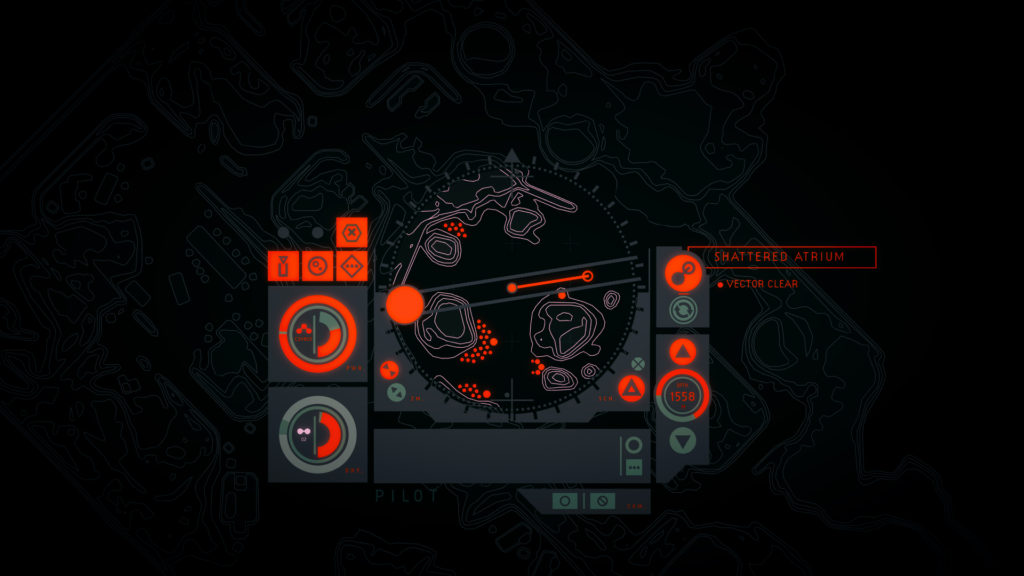
That’s a key element of In Other Waters, the relaxing pace and lack of pressure. The game is spent guiding Ellery to her goal, but it’s done in such a manner that even the highest pressure situations don’t really stress you out. Colors shift slowly through the game to reveal different environments, sometimes subtle, sometimes noticeably vivid, but everything coalesces into a seamless experience that is carried by the brilliant narrative, transcending simple text and managing to immerse the player into the oceans of the planet Gliese. To this end, the music and sound in In Other Waters is unique and perfectly tailored to the game. The alien ocean life has a myriad of audible responses to stimuli, blooping, thrumming, and hissing through the waters around Ellery. She reacts to creatures and environments but you never see it, instead depending entirely on the sounds coming through her microphone and leaving the majority of the game’s experiences up to your imagination. This of course, makes sound design incredibly important, and there’s no shortage of skill here. The music of In Other Waters syncs with sound and storyline throughout the game, accentuating key points in the plot and smoothing the way for your explorations through the waters of the planet. Note that if you are playing undocked, a pair of headphones is highly recommended as you get a much better sense of the sound design than you will through the speakers of the system.
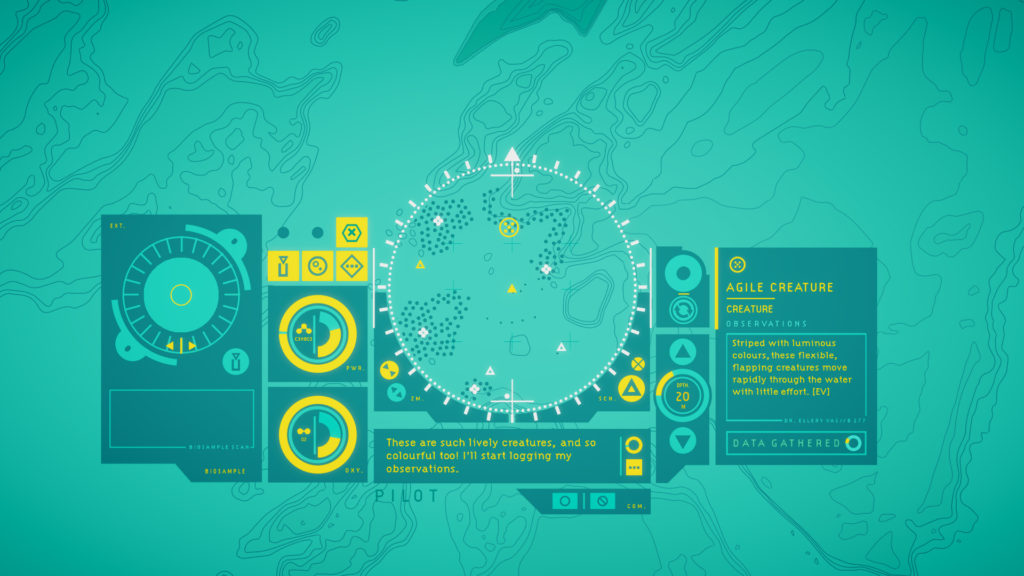
However, not every single thing is perfect. In Other Waters has a few slight issues that won’t resonate with every player. One of those is the pacing. While it is an absolutely fantastic game, there are sections of the game that can feel slow and plodding due to the methodical pace at which you move. It can be frustrating seeing where you need to go, scanning, and finding a triangle movement marker that simply doesn’t take you there. This is a guided tour with strictly delineated boundaries, and there is no deviation from the pacing. That’s not to say it’s boring, just that if you’re in a hurry or want to move past some parts to get to the ‘meat’ of the story, you honestly can’t. In Other Waters simply isn’t designed that way and you literally miss the point of the game if you start skimming through Ellery’s statements and commentaries about the flora and fauna around her. This is an experience tailored to a more patient style of gaming, forcing you to take your time and observe.
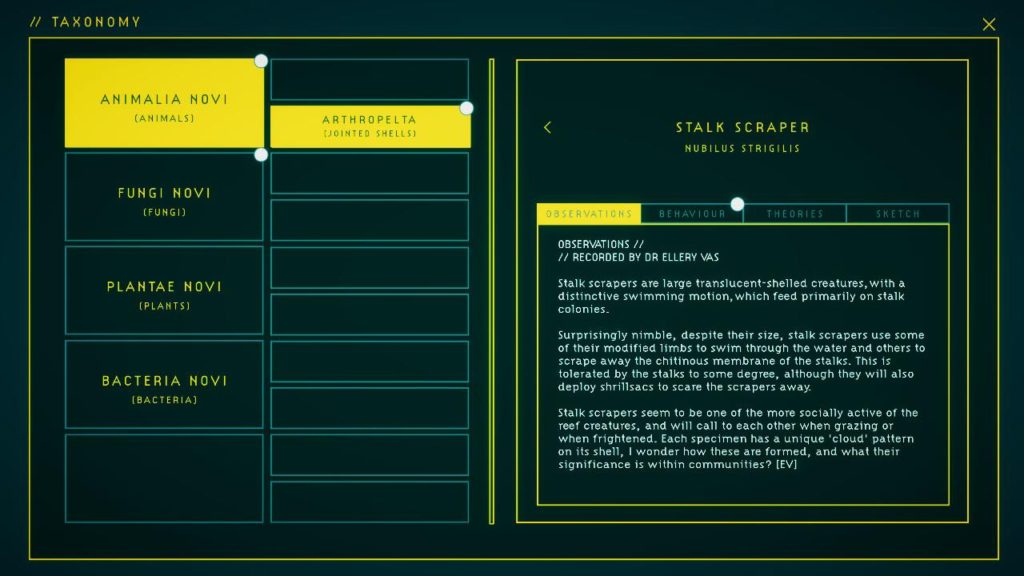
As previously stated, for a minimalist game, In Other Waters is an absolute powerhouse visually. Everything is responsive and pleasing to the eye. However, particularly with the Switch, there are a couple of small issues. If you’re playing in handheld mode, everything is touch sensitive and it works absolutely fabulously. It’s practically instinctive the way every single control responds exactly as you’d expect it to on the touch screen with nary a hitch. However, there’s one tiny design problem. Ellery’s text box is absolutely miniscule. Design-wise this makes sense but for anyone that needs a larger font, you’re out of luck. Hopefully you have glasses, because you’ll definitely need them with the tiny yellow text, depending on the background color at the time. Prepare to have your nose right up to the screen because it’s just hard to see.
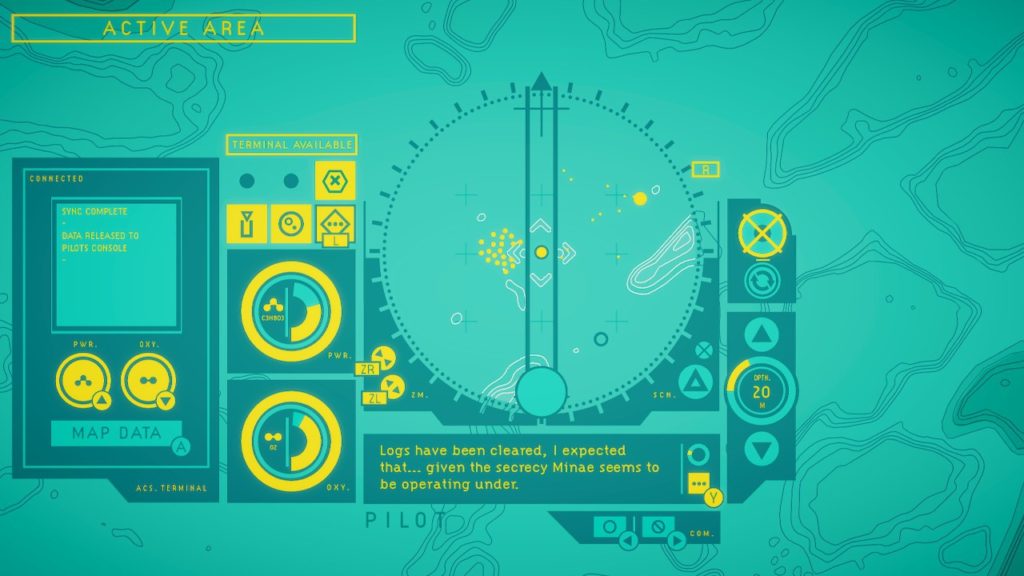
On that note, if you happen to skip a statement from Ellery with enthusiastic button pressing or touches, you might be in trouble. There are no notifications of key statements and no log (weird for an AI) to check back on to see what she said. You might easily miss a key point and end up stuck or lost until you intuit what to do or go back to your last save *cough* and re-read everything more carefully. All the information is there, but it’s on you to gather it. Additionally, when you dock your Switch and transition to controller play, it feels wrong at first. The difference between touch context and button-based control is abrupt and jarring and it’s hard to regain immersion. Both issues are really quibbles though, as the game is a piece of art as much as everything else.
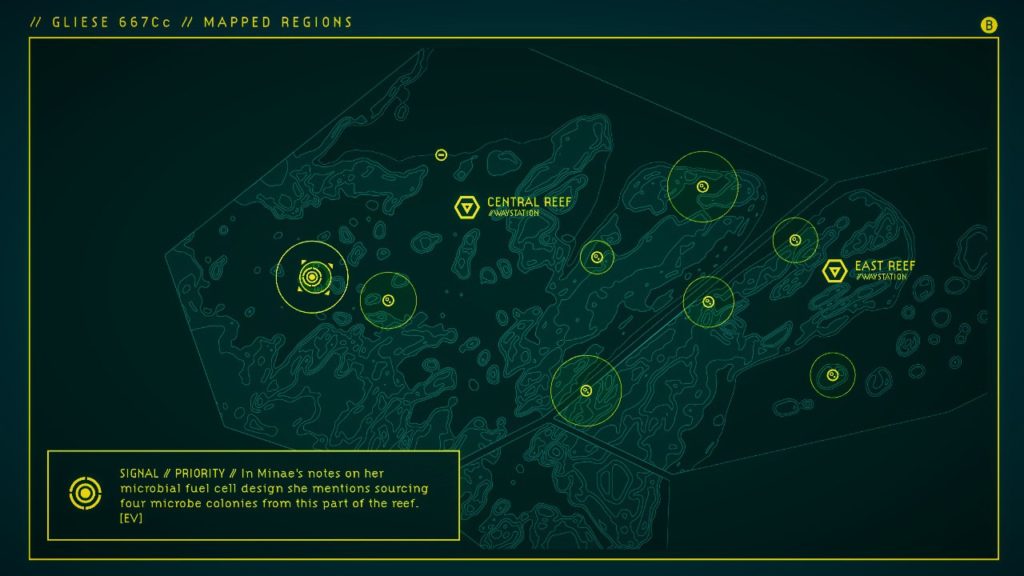
Speaking of art, one of the main activities in In Other Waters is classifying the alien wildlife. As you travel with Ellery, you’ll gather information about both her and the animals and plants around you. She logs it all and when you visit the lab, you can check the taxonomy of each creature. Their entries record all of the data Ellery has taken note of and if you gather it all, you see a fantastic rendition of the creature drawn by Ellery in the style of a vintage 1800s biology textbook. These are the only graphics in the game aside from the myriad of windows and controls available to you and after so long without imagery, they’re lush and exotic, teeming with otherworldly potential.

You wouldn’t think a game with virtually no graphics and a methodical pacing could keep up with today’s extreme gaming, but In Other Waters manages to not only hearken back to the days of the classic text adventure but also skillfully updates that vintage gameplay to appeal to a much wider audience of modern gamers. This is a title that will appeal to both casual and hardcore gamers alike but definitely isn’t for everyone. At $15, it’s reasonably priced for the seven to ten hours you’ll get out of it, not dragging on forever with filler or ridiculously short. It’s a niche title, but In Other Waters is also a fantastic experience unlike anything else on the market. Part art house production, part deep science fiction storyline, and altogether fascinating, In Other Waters manages to weave a believable world with complex rules and patterns almost entirely in your mind and allows you the privilege of interacting with it.
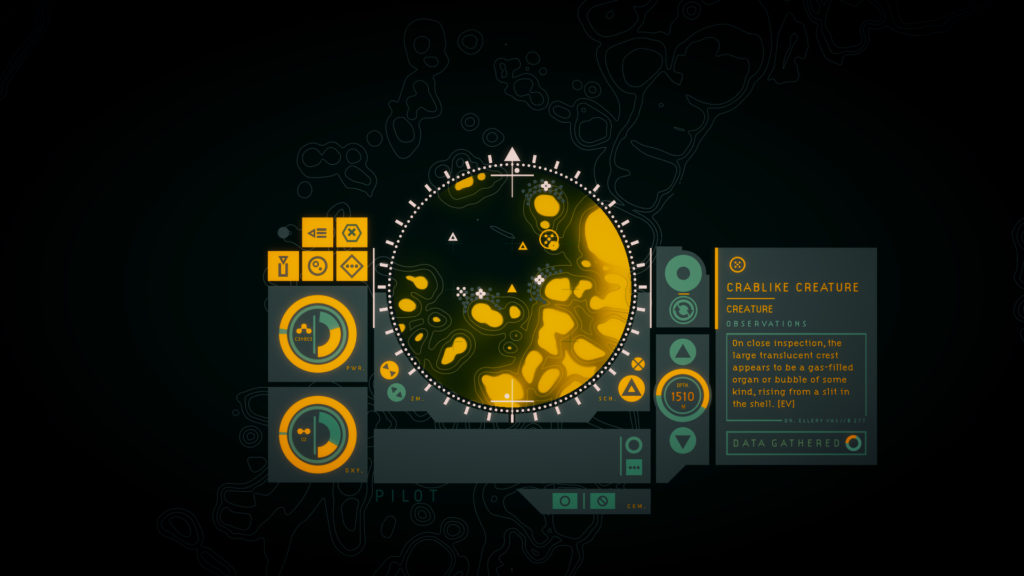
This review was based on a digital copy of In Other Waters provided by the publisher. It was played on a Nintendo Switch in both docked and undocked modes, but primarily in undocked mode. In Other Waters is also available on Steam, GOG, and the Humble Store!

